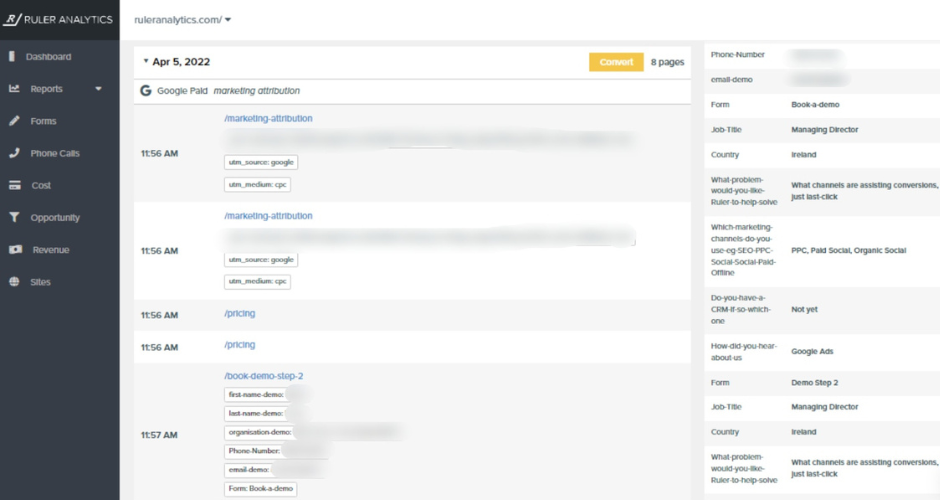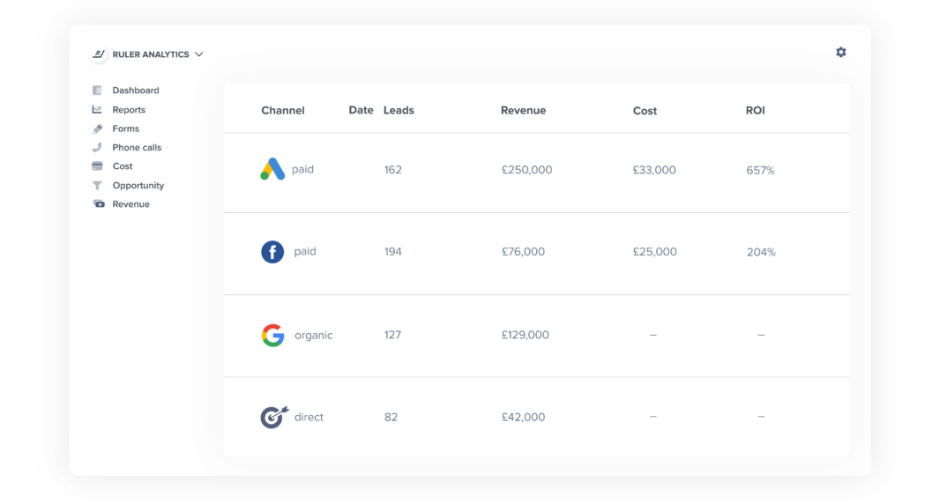Integrate your data and understand which channels drive the highest quality leads, customers and revenue with Ruler Analytics.
If you’ve landed on this blog post, you probably already have a solution in place to align your sales, marketing and customer data.
But chances are you’re here because you’re looking for a better solution that can provide you with more benefits and flexibility.
If so, you’ve come to the right place.
At Ruler Analytics, we’ve helped tons of marketers increase revenue and validate the success of their strategies by integrating data from many different sources.
Don’t just take our word for it. We have plenty of content on how we’ve helped other businesses track and improve their ROI.
But how can Ruler help you and your team?
To show you, let’s look at how Ruler works, what data it tracks and how it integrates seamlessly with other platforms.
In this article, we’ll discuss:
💡 Pro Tip
Want to skip this article and start your journey with Ruler? Book a demo to see Ruler in action and see how it can help with your data-driven decision-making and close more higher-value deals.
Book a free demo of Ruler
Before we get under the hood of Ruler, let’s pause to highlight the importance of integrating your marketing, sales and customer data.
The need for data integration is becoming a more and more central topic. According to a study, the data integration software market is projected to grow from $11.94 billion in 2022 to $29.16 billion by 2029.
But what makes data integration so critically important? Let’s explore some of the benefits to explain.
Integrating your data provides a bigger picture across the organisation. It breaks down the silos and gives your teams a single source of truth on leads and customers. It allows them to track progress collectively and work closer together to convert more leads into deals.
Another stand-out benefit of data integration is how much time and money it can save in the long run. By allowing your data to flow seamlessly between your tools, you reduce the need for human intervention. That means your teams can focus on more strategic tasks, such as developing new campaigns or refining existing ones.
The more relevant data you have, the better position you’ll be in to make informed decisions. By leveraging data integration across your tools, you’re able to power your team’s strategic and tactical decisions to prove ROI and drive revenue.
Data provides the fuel for a competitive advantage. With the right data, you can see what your customers are thinking, allowing you to gain an understanding of what they truly want. You can use this insight to blow your competition out of the water by creating remarkable experiences for your ICP (ideal customer profile).
Data integration offers numerous benefits. It makes it easier for companies to recognise challenges and opportunities to drive data-driven decisions.
Related: A complete guide to data-driven marketing
But with the good comes the bad.
Successful data integration has a list of challenges that make it hard for businesses to connect their data across a range of sources.
Some of those challenges include:
Honestly, these challenges alone are enough to make you dizzy. But the biggest obstacle for most companies is the data silo.
The stats back it up. 54% of organisations stated that their biggest barrier to leveraging data was fragmented or siloed applications, and 47% said that data was siloed and difficult to access.
Teams across all organisations are collecting data through a variety of applications, such as marketing analytics, CRM, customer success tools and others.
And each one of these tools is accessed and managed by different teams.
Take Google Analytics, for example.
Google Analytics is a marketers’ best friend. In fact, 90% of marketers consider Google Analytics their go-to solution for performance tracking.
We can’t say we’re surprised. Google Analytics offers a wealth of information on website visitor behaviour and marketing performance.
The sales team, however, will rely on data and insights in the CRM. And who can blame them? The CRM holds every piece of information you have on a potential lead or customer.
Both Google Analytics and CRM systems have their benefits, but neither can offer a full story of what’s happening alone.
But this is where tools like Ruler come to the rescue.
Ruler is an attribution tool for marketers that are focused on creating and executing marketing strategies to drive more revenue.
It provides businesses with a holistic view of their customers’ journeys, allowing them to see what is (and isn’t) working to drive profitable outcomes.
Ruler does this by integrating your existing data sources such as your marketing analytics, CRM and subscription tools to gain full transparency into your customer touchpoints.
With Ruler, marketers can showcase their successes and:
💡 Pro Tip
If you think that’s great, Ruler has plenty of features to help track and analyse your marketing performance. We won’t go into it here as we have a complete guide that covers all the features available in Ruler and more.
Everything you can discover in Ruler
Ruler pretty much sits on the fence between your marketing, sales and customer tools.
It captures each marketing touchpoint for every new and existing lead and sends the data to your CRM, allowing you to keep track of your marketing effectiveness at every stage of the pipeline.
When a lead closes on a deal, their conversion details and marketing touchpoints are passed onto your customer data platform and other analytics tools.
This allows you to see exactly which campaigns, channels and keywords have the greatest impact on customers and recurring revenue.
Let’s run the process together in a bit more detail.
Ruler uses first-party cookies to track your visitors.
Related: How to view full customer journeys with Ruler
When a user visits your website for the first time, Ruler will assign a unique identifier to their session.
Below is an example of Ruler tracking a visitors journey in its dashboard.

Every time this user returns to your website, Ruler’s code will fire and automatically associate that visitor with their previous sessions to create a cross-channel journey.
Let’s break it down with an example. Let’s say you own a car dealership.
Sara searches on Google. She uses the keyword “car dealership near me” and finds your website after clicking on a Google Ad. In this scenario, Ruler will track the GCLID data from your paid ad to record her visit. Sara takes a look around and eventually leaves.
A few days later, Sara clicks on a retargeting ad on Facebook and returns to your website. Sara takes another look around your website, but instead of leaving, Sara fills out a form on your website for a free test drive.

Thanks to first-party cookies, Ruler can link both visits together.
Not only can Ruler track Sara’s cross-channel journey, but it can also show what ads, keywords and landing pages she engaged with along the way.
When a visitor completes a conversion, Ruler fires the user and their marketing source data over to your CRM or sales system.
A conversion could happen via form fill, live chat or over the phone.
Once the data is transferred, the person is considered a lead.
This allows your sales team to see exactly where your leads came from, what pages they visited, and how they converted from anonymous visitors into potential prospects.
Let’s use the example above to demonstrate.
Remember Sara found your website using Google Ads and converted using Facebook? This is what it would look like in your CRM.

If it wasn’t for Ruler, the only thing your sales team would see in your CRM is this:

But why is this data so important? Well, it closes the gap between your marketing and sales team initiatives. Ruler’s lead source data lets you organise and track your lead information and interactions in a single view.
Related: Track where your leads came from with Ruler
As leads move down the funnel, you and your teams can determine which marketing and sales efforts are resonating best with your highest quality leads and optimise accordingly.
It’s a win-win situation for all teams involved.
But the best is yet to come.
When your lead converts into a sale, no matter how long after their first session, Ruler will utilise a pre-built integration to fire conversion and revenue data to its dashboard and your other favourite marketing apps.

Ruler will scrape the closed revenue from your CRM and share it with apps like Google Ads, Facebook Business Manager and Google Analytics.
Related: How Ruler enriches Google Analytics with attribution data
This allows your marketing team to identify which marketing channels, campaigns, and ads are generating the most revenue.
Take the example below.

In this acquisition report, you can see that Facebook and Instagram have contributed a similar number of leads. If you were handed more budget to increase revenue, where would you invest it? Likely, Facebook and Instagram.
Now, let’s add revenue data from Ruler.

Big difference, right? We can now see that Facebook had the best impact on the business.
Sounds great, but how does this benefit your customer success teams?
Well, Ruler doesn’t just stop at your marketing apps. It also integrates with your revenue and subscription tools.
Take Chartmogul, for example.
Here at Ruler, we send all our sales and attribution data to a Google Sheet. This data syncs with ChartMogul periodically throughout the day.
In ChartMogul, we’ve set up custom attributes to capture the marketing and enriched company data. This allows us to manipulate data to create custom reports with Chartmogul.

Related: How Ruler uses ChartMogul to close the loop between marketing and customer revenue
ChartMogul also connects with our payment processor, allowing us to track any subsequent sales and measure the impact of our marketing based on monthly recurring revenue.
By integrating Ruler’s data with Chartmogul, we can:
There are tons of benefits to integrating your data with Ruler.
First, Ruler allows you to establish a direct connection between your marketing campaigns, leads and customers.
Second, it helps you better understand how your marketing supports your pipeline generation, specifically revenue.
What’s not to love?
We have plenty of content on how Ruler attributes revenue to your marketing and how it can help improve your ROI.
Or, if you’d like to see Ruler in action, book a demo and get a more in-depth look at how Ruler can help your business.
